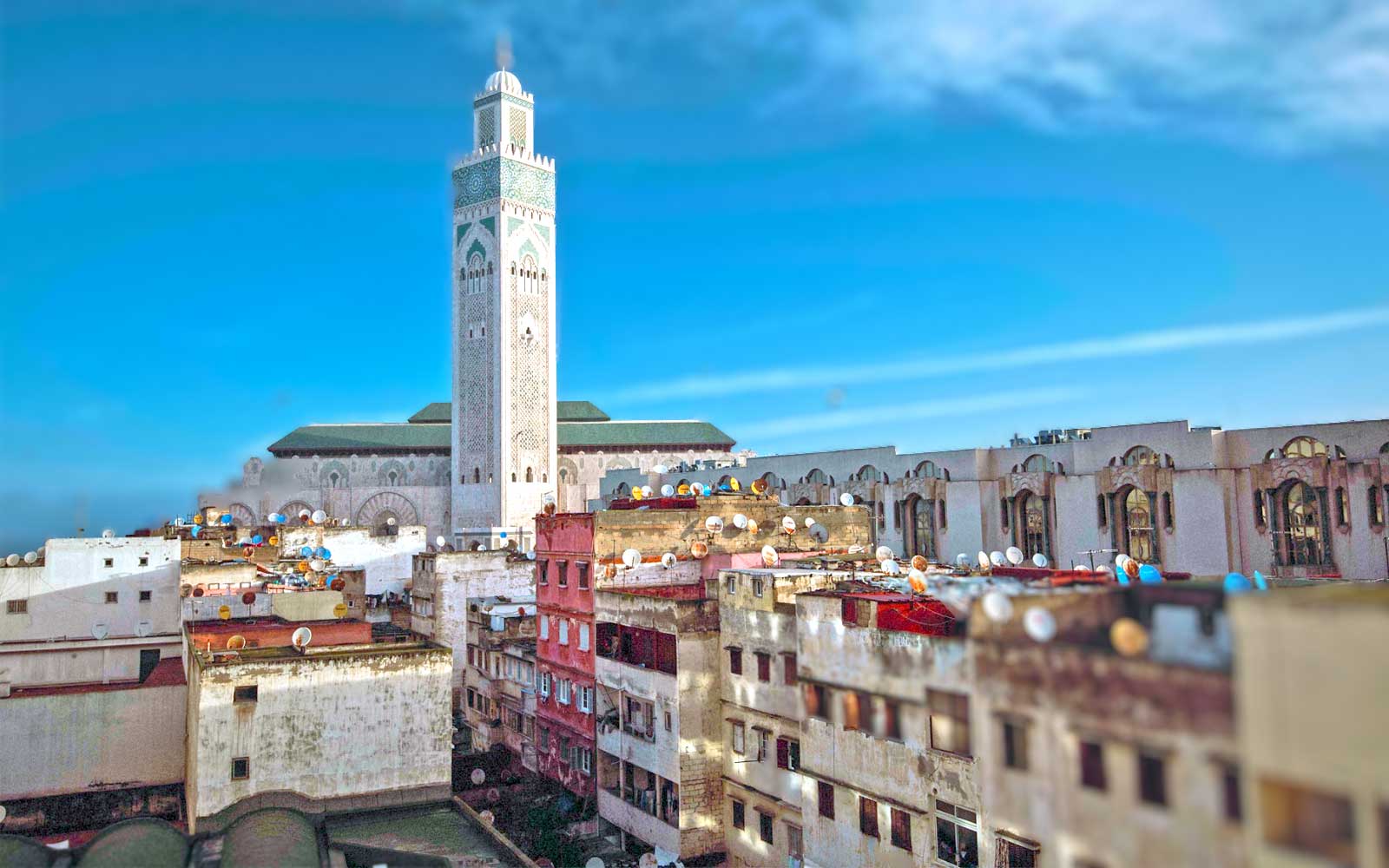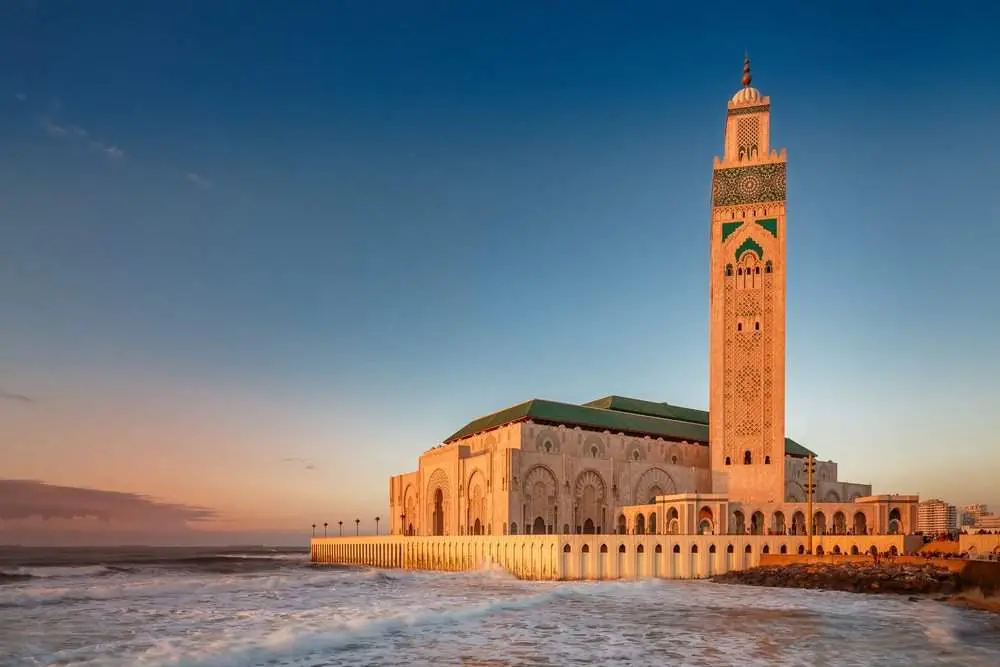
Casablanca, Morocco’s largest city and economic heart, is a captivating blend of history, modernity, and vibrant culture. While often perceived as a business hub, Casablanca offers a rich tapestry of experiences for travelers, from exploring its stunning architecture and historical landmarks to indulging in its bustling souks and savoring its delicious cuisine. This comprehensive guide will equip you with everything you need to plan your perfect trip to Casablanca, covering its top attractions, history, travel tips, accommodation options, transportation, and the best time to visit.
A Glimpse into Casablanca’s Past: A History of Transformation
Casablanca’s history is a story of constant evolution, shaped by diverse influences from Berber origins to French colonial rule. Originally a small Berber settlement known as Anfa, it was destroyed by the Portuguese in the 15th century and later rebuilt in the 16th century, becoming known as Casa Branca (White House in Portuguese).
/GettyImages-625321358-58e24c335f9b58ef7e5529e7.jpg)
Related Articles about Casablanca Calling: Your Comprehensive Guide to Morocco’s Vibrant Metropolis:
- Chile: A Tapestry of Extremes and Unforgettable Stays – Your Ultimate Travel Guide
- Nepal: A Journey to the Roof of the World and Beyond
- The City of Gold: Unveiling the Vibrant Tapestry of Johannesburg
- Dublin’s Embrace: A Guide to the Best Hotels and Unforgettable Experiences
- Unveiling Vietnam: A Comprehensive Guide to Your Southeast Asian Adventure
In the 18th century, Sultan Mohammed ben Abdallah rebuilt the city after an earthquake, naming it Dar el Beida (White House in Arabic), which eventually morphed into the French "Casablanca." The city remained relatively small until the French protectorate was established in 1912. Under French rule, Casablanca underwent rapid modernization, becoming a major port and economic center.
World War II played a significant role in Casablanca’s history, hosting the historic Casablanca Conference in 1943, where Allied leaders Franklin D. Roosevelt and Winston Churchill met to discuss war strategy.
Morocco gained independence in 1956, and Casablanca continued to flourish as its economic powerhouse. Today, it stands as a dynamic metropolis, balancing its rich historical heritage with its modern ambitions.
Unveiling Casablanca’s Treasures: Top Attractions to Explore
Casablanca boasts a wealth of attractions that cater to diverse interests. Here are some must-see destinations:
-
Hassan II Mosque: A true architectural masterpiece and one of the largest mosques in the world, the Hassan II Mosque is a breathtaking spectacle. Its intricate details, exquisite craftsmanship, and stunning location on the Atlantic coast make it an unforgettable experience. Non-Muslims can take guided tours to explore its interior, admiring the marble floors, intricate mosaics, and towering minaret.
-
The Corniche (Ain Diab): Casablanca’s vibrant beachfront promenade, known as the Corniche, is a hub of activity. Lined with cafes, restaurants, hotels, and nightclubs, it offers a perfect spot to relax, enjoy the sea breeze, and soak in the city’s lively atmosphere. During the day, you can lounge on the beach, swim in the ocean, or try watersports. In the evening, the Corniche comes alive with music and entertainment.
-
Habous Quarter (New Medina): This charming neighborhood, also known as the New Medina, was built by the French in the 1930s to alleviate overcrowding in the old Medina. It offers a more organized and relaxed atmosphere compared to other Moroccan Medinas, with its narrow streets, traditional architecture, and a wide array of shops selling handicrafts, spices, and local products. It’s a great place to experience the authentic Moroccan atmosphere without the intensity of the older medinas.
-
Place Mohammed V: The heart of Casablanca’s administrative district, Place Mohammed V is a grand square surrounded by impressive colonial-era buildings. Its architecture reflects the French influence on the city, showcasing a blend of Art Deco and Moorish styles. The square is a popular gathering place for locals and visitors alike, offering a glimpse into Casablanca’s urban life.
-
Villa des Arts: Housed in a beautiful Art Deco villa, the Villa des Arts is a prominent art gallery showcasing contemporary Moroccan art. It’s a great place to discover the talent of local artists and gain insights into the contemporary art scene in Morocco.
-
Mahkama du Pacha (Pasha’s Courthouse): This stunning building, originally built as a courthouse, is a hidden gem showcasing intricate Moroccan craftsmanship. Its interiors are adorned with intricate tilework, stucco carvings, and elaborate cedarwood ceilings, reflecting the rich artistic heritage of the region. Although it’s not always open to the public, it’s worth trying to visit if you have the opportunity.
-
The Old Medina: While smaller and less elaborate than the medinas in other Moroccan cities like Fez and Marrakech, Casablanca’s Old Medina offers a glimpse into the city’s historical roots. It’s a labyrinthine network of narrow streets, traditional shops, and local eateries. Be prepared to haggle for souvenirs and immerse yourself in the authentic Moroccan atmosphere.
-
Sacré-Cœur Cathedral: This abandoned cathedral, built in the 1930s, is a unique example of Art Deco architecture with Neo-Gothic elements. Though no longer used for religious services, it stands as a striking landmark and a testament to the city’s colonial past. It offers stunning panoramic views of Casablanca from its towers.

Planning Your Trip: Essential Travel Tips for Casablanca
-
Visa Requirements: Check visa requirements for your nationality before traveling to Morocco. Many nationalities can enter Morocco visa-free for a limited period.
-
Currency: The Moroccan currency is the Dirham (MAD). ATMs are widely available in Casablanca, and credit cards are accepted in larger establishments. However, it’s advisable to carry cash for smaller shops and souks.
-
Language: Arabic is the official language, but French is widely spoken, especially in business and tourist areas. English is also spoken in some hotels and tourist establishments. Learning a few basic Arabic phrases can enhance your interactions with locals.
-
Dress Code: While Casablanca is a relatively modern city, it’s advisable to dress modestly, especially when visiting religious sites. Women should cover their shoulders and knees.
-
Safety: Casablanca is generally safe for tourists, but it’s important to be aware of your surroundings and take precautions against petty theft, especially in crowded areas. Avoid walking alone in poorly lit areas at night.
-
Haggling: Haggling is a common practice in the souks and markets. Be prepared to negotiate prices and don’t be afraid to walk away if you’re not happy with the offer.
-
Tipping: Tipping is customary in Morocco. It’s common to tip waiters, taxi drivers, and hotel staff.
-
Water: Drink bottled water to avoid stomach problems.
-
Respectful Behavior: Be respectful of local customs and traditions. Avoid public displays of affection and refrain from photographing people without their permission.
Finding Your Perfect Stay: Accommodation Options in Casablanca
Casablanca offers a wide range of accommodation options to suit different budgets and preferences:
-
Luxury Hotels: For a luxurious experience, consider staying at one of Casablanca’s upscale hotels, such as the Four Seasons Hotel Casablanca, Hyatt Regency Casablanca, or Sofitel Casablanca Tour Blanche. These hotels offer world-class amenities, stunning views, and impeccable service.
-
Mid-Range Hotels: There are numerous mid-range hotels that offer comfortable accommodations and good value for money. Some popular options include Hotel Kenzi Basma, Hotel Club Val d’Anfa, and Hotel Le Casablanca.
-
Budget Hotels and Riads: For budget travelers, there are several affordable hotels and riads (traditional Moroccan houses with interior courtyards) in the Medina and other parts of the city. These options offer basic amenities and a more authentic Moroccan experience.
-
Apartments and Guesthouses: Renting an apartment or staying in a guesthouse is a good option for those who prefer more independence and a local experience.
Getting Around Casablanca: Transportation Options
-
Taxis: Taxis are the most convenient way to get around Casablanca. There are two types of taxis: "petits taxis" (small taxis) for short distances within the city and "grands taxis" (large taxis) for longer distances and travel outside the city. Make sure the driver uses the meter or agree on a fare before starting your journey.
-
Tramway: Casablanca has a modern tramway system that connects several parts of the city. It’s a convenient and affordable way to travel, especially during peak hours.
-
Buses: Buses are a cheap but often crowded way to get around Casablanca.
-
Train: Casablanca has two main train stations: Casa Voyageurs and Casa Port. Casa Voyageurs is the main station for long-distance trains, while Casa Port is located near the port and serves regional trains.
-
Rental Cars: Renting a car can be a good option for exploring the surrounding areas of Casablanca, but driving within the city can be challenging due to traffic congestion.
The Best Time to Visit Casablanca: Weather and Festivals
The best time to visit Casablanca is during the spring (April-May) and autumn (September-October) months. The weather is pleasant, with warm temperatures and sunny skies.
-
Summer (June-August): Can be hot and humid, especially in July and August.
-
Winter (November-March): Can be cool and rainy.
Casablanca also hosts several festivals and events throughout the year:
-
Jazzablanca (April): A renowned international jazz festival featuring renowned artists from around the world.
-
Festival of Casablanca (July): A celebration of Moroccan culture with music, dance, and theatrical performances.
-
Eid al-Fitr and Eid al-Adha: Important Islamic holidays that are celebrated with family gatherings and religious observances.
Casablanca: A City of Contrasts Awaits
Casablanca is a city of contrasts, where ancient traditions meet modern aspirations. It’s a place where you can explore historical landmarks, indulge in delicious cuisine, and experience the vibrant culture of Morocco. By following this comprehensive guide, you can plan your perfect trip to Casablanca and create unforgettable memories in this captivating metropolis. So, pack your bags and prepare to be enchanted by the charm and allure of Casablanca!





